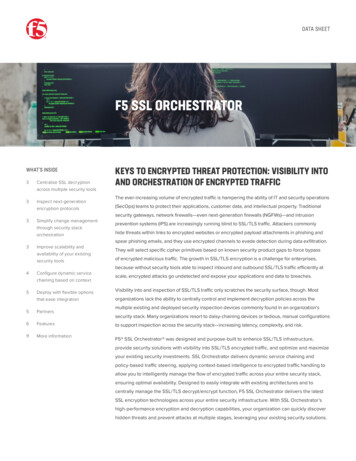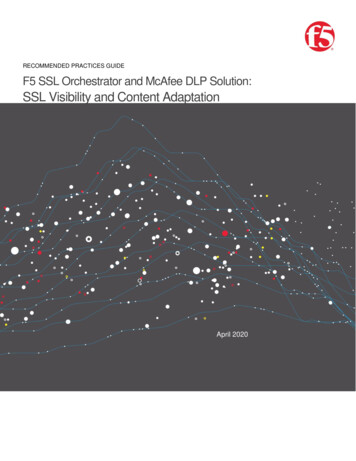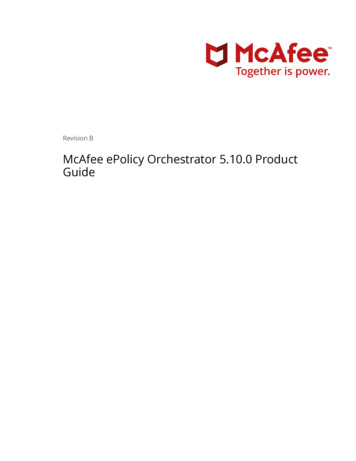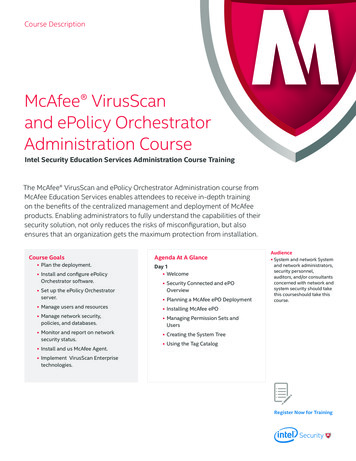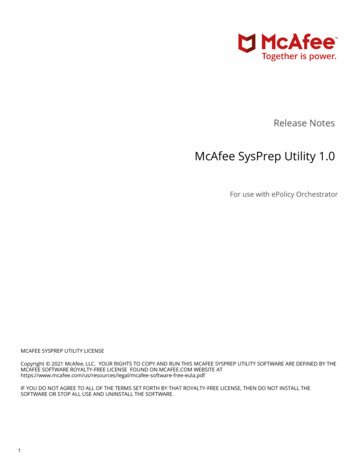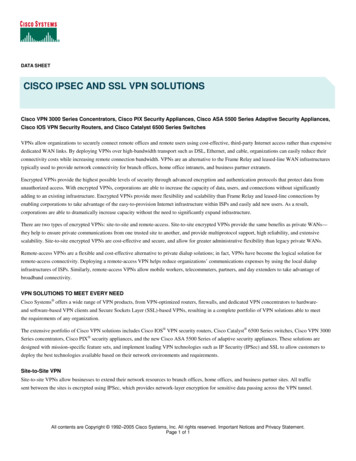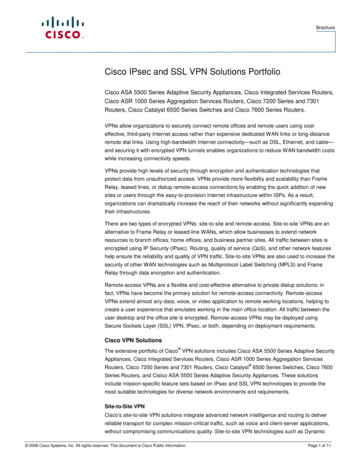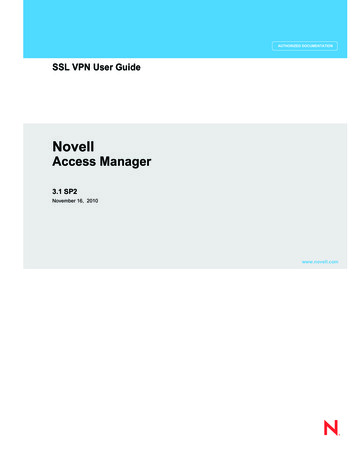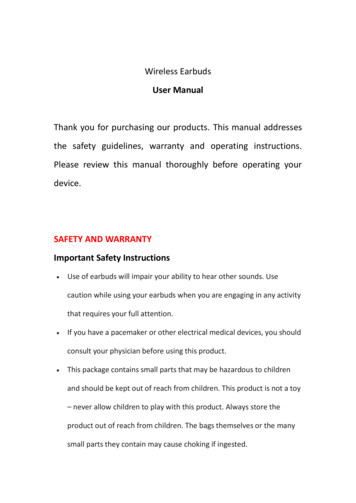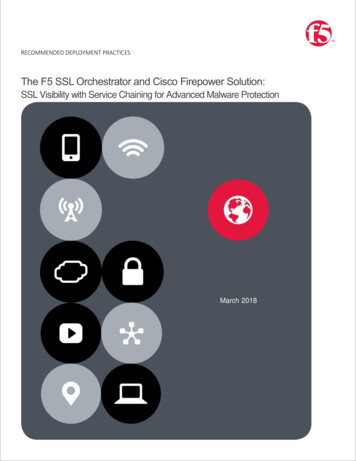
Transcription
RECOMMENDED DEPLOYMENT PRACTICESF5 and Cisco FirePower SSL Orchestration with Service ChainingRECOMMENDED DEPLOYMENT PRACTICESThe F5 SSL Orchestrator and Cisco Firepower Solution:SSL Visibility with Service Chaining for Advanced Malware ProtectionMarch 20181
ContentsIntroduction .3The Integrated Solution .3SSL visibility: How do we do it? . 4SSL orchestration using security service chains . 5Deployment Planning .6Sizing . 6License components . 7Horizontal scaling . 7Traffic exemptions for SSL inspection. 8Certificate requirements . 9IP addressing . 9Deployment modes . 10Initial Setup .11Run the SSL Orchestrator Setup Wizard . 12Update the SSL Orchestrator version . 15Back up your F5 system configuration . 17Configuration for a Single F5 System with FirePOWER Services on Cisco ASA in L2 Mode(Burrito Design) .18Configure SSL Orchestrator . 19Create layer 2 inline service . 23Configuration for an F5 System with FirePOWER Services on Cisco ASA in L3 Mode .25Create the layer 3 inline service . 25Configuration for the F5 System with Cisco ASAs in TAP Mode .26Create a receive-only service . 27Alternative Architectures .28Two F5 systems with ASAs deployed as a service pool . 28Two F5 systems with firewalls sandwiched in the decryption zone . 31Creating service chains to link services. 34Creating TCP service chain classifier rules . 34Handling NAT.37Testing the Solution.38
RECOMMENDED DEPLOYMENT PRACTICESF5 and Cisco Firepower SSL Visibility with Service ChainingIntroductionThe Secure Sockets Layer (SSL) protocol and its successor, Transport Layer Security (TLS), have been widelyadopted by organizations to secure IP communications, and their use is growing rapidly. While SSL provides dataprivacy and secure communications, it also creates challenges to inspection devices in the security stack wheninspecting the encrypted traffic. In short, the encrypted communications cannot be seen as clear text and are passedthrough without inspection, becoming security blind spots. This creates serious risks for businesses: What if attackersare hiding malware inside the encrypted traffic?However, performing decryption of SSL/TLS traffic on the security inspection devices, with native decryption support,can tremendously degrade the performance of those devices. This performance concern becomes even morechallenging given the demands of stronger, 2048-bit certificates.An integrated F5 and Cisco Advanced Malware Protection (AMP) solution solves these two SSL/TLS challenges. F5 SSL Orchestrator centralizes SSL inspection across complex security architectures, enabling flexible deploymentoptions for decrypting and re-encrypting user traffic. It also provides intelligent traffic orchestration using dynamicservice chaining and policy-based management. The decrypted traffic is then inspected by one or more Cisco nextgeneration firewalls (NGFWs), which can prevent previously hidden threats and block zero-day exploits. The CiscoFirepower Threat defense may be delivered using several combinations of Cisco Firepower and ASA platforms andsoftware images. This solution eliminates the blind spots introduced by SSL and closes any opportunity foradversaries.This guide provides an overview of the joint solution, describes different deployment modes with reference to servicechain architectures, recommends practices, and offers guidance on how to handle enforcement of corporate Internetuse policies.The Integrated SolutionThe F5 and Cisco integrated solution enables organizations to intelligently manage SSL while providing visibility intoa key threat vector that attackers often use to exploit vulnerabilities, establish command and control channels, andsteal data. Without SSL visibility, it is impossible to identify and prevent such threats at scale.Key highlights of the joint solution include: Flexible deployment modes that easily integrate into even the most complex architectures, consolidatethe security stack to reduce complexity, and deliver SSL visibility across the security infrastructure. Centralized SSL decryption/re-encryption with best-in-class SSL hardware acceleration, eliminatingthe processing burden of multiple decryption/re-encryption workloads on every security inspection hop inthe stack, which reduces latency while improving the user experience. Dynamic security service chaining, which provides policy-based traffic management, thus determiningwhether traffic should be allowed to pass or be decrypted and sent through a security device or service.3
RECOMMENDED DEPLOYMENT PRACTICESF5 and Cisco Firepower SSL Visibility with Service Chaining An industry-leading application delivery controller that load balances traffic to multiple devices in thesecurity services, enabling effortless scaling and growth. Built-in health monitors that detect security service failures and shifts, or bypasses, loads in real timeto provide reliability and fault tolerance. Full cipher support, including support for the perfect forward secrecy (PFS) enabled ciphers, to ensurefull traffic visibility. Advanced sandboxing capabilities to perform automated static and dynamic analysis, then uncoverstealthy threats and help the security team to understand, prioritize, and block sophisticated attacks. Point-in-time malware detection and blocking using anti-virus (AV) detection engines, one-to-onesignature matching, machine learning, and fuzzy fingerprinting. Global threat intelligence sharing by Cisco experts who analyze millions of malware samples andpush that intelligence to AMP to correlate against this context-rich knowledge base, which enables it toproactively defend against known and emerging threats.F5 SSL Orchestrator installs a decryption/clear text zone between the client and web server, creating an aggregation(and, conversely, disaggregation) visibility point for security services.Figure 1: The integrated F5 and Cisco Firepower security solutionSSL visibility: How do we do it?The F5 system establishes two independent SSL connections—one with the client and the other with the web server.When a client initiates an HTTPS connection to the web server, the F5 system intercepts and decrypts the clientencrypted traffic and steers it to a pool of Cisco Firepower devices (or devices running FirePOWER Services) for4
RECOMMENDED DEPLOYMENT PRACTICESF5 and Cisco Firepower SSL Visibility with Service Chaininginspection before re-encrypting the same traffic to the web server. The return HTTPS response from the web serverto the client is likewise intercepted and decrypted for inspection before being sent on to the client.Figure 2: The F5 full proxy architectureSSL orchestration using security service chainsA typical security stack often consists of more than advanced anti-malware protection systems. It begins with afirewall but almost never stops there, with components such as intrusion detection/prevention systems (IDS/IPS), webapplication firewalls, data loss prevention (DLP), and more. To solve specific security challenges, securityadministrators are accustomed to manually chaining these multiple point security products by creating a bare-bonessecurity stack consisting of multiple services. In this model, all user sessions are provided the same level of security,as this “daisy chain” of services is hard-wired.As shown in Figure 3, SSL Orchestrator can load balance, monitor, and dynamically chain security services, includingnext-gen firewalls, DLP, IDS/IPS, web application firewalls, and anti-virus/malware, by matching the user-definedpolicies to determine whether to bypass or decrypt and whether to send to one set of security services or another.This policy-based traffic steering capability allows for better utilization of the existing security services investment andhelps to reduce administrative costs.5
RECOMMENDED DEPLOYMENT PRACTICESF5 and Cisco Firepower SSL Visibility with Service ChainingFigure 3: The security service chaining architectureThe F5 SSL visibility solution provides a way to apply different service chains based on context derived from apowerful classification engine. That context can come from: Source IP/subnet. Destination IP/subnet. IP intelligence category. IP geolocation. Host and domain name. URL filtering category. Destination port. Protocol.Deployment PlanningCareful advance consideration of deployment options can ensure an efficient and effective implementation of the F5integrated solution using the Cisco Firepower security system.SizingThe main advantage of deploying SSL Orchestrator in the corporate security architecture is that the wire traffic nowcan be classified as “interesting” traffic, which needs to be decrypted by SSL Orchestrator for inspection by Cisco6
RECOMMENDED DEPLOYMENT PRACTICESF5 and Cisco Firepower SSL Visibility with Service ChainingFirepower, and “uninteresting” traffic, which is allowed to pass through or be processed differently according to othercorporate policy requirements. This selective steering of only the interesting traffic to the firewall system conserves itsvaluable resources (as it need not inspect the entire wire traffic), maximizing performance.As a result, it is important to consider the entire wire traffic volume to calculate the appropriate F5 device size.Depending on the mode of deployment you choose, you will need at least two interfaces on the F5 system for eachfirewall configured for inline mode and at least one interface for each firewall configured for TAP mode.Refer to the SSL Orchestrator Datasheet and consider the following factors when sizing the F5 system for theintegrated solution: Port density SSL bulk encryption throughput System resources The number of security services and devices in themLicense componentsF5 SSL Orchestrator hardware—the i2800, i5800, i10800—supports this integration. By default, SSL Orchestratorships with an installed base module that provides both SSL interception and service chaining capabilities.SSL Orchestrator can also be deployed as an application on an existing F5 BIG-IP system. Please contact yourlocal F5 representative to understand the licensing and deployment options. For simplicity’s sake, references to SSLOrchestrator and the BIG-IP system in this document (and some user interfaces) apply equally regardless of the F5hardware used. The solution architecture and configuration are identical.Optionally, customers can consider the following: A URL Filtering (URLF) subscription to use the URL category database for filtering. An F5 IP Intelligence subscription to detect and block known attackers and malicious traffic. A network hardware security module (HSM) to safeguard and manage digital keys for strongauthentication.Cisco Firepower can be deployed: Via Firepower Threat defense (a unified software image) on the ASA 5000x and Firepower 2100/4100/9300platforms. Via FirePOWER services on a separate FirePOWER module on an ASA ASA 5500x platform.Horizontal scalingSSL Orchestrator’s ability to steer and load-balance traffic to multiple security devices in a service or service poolenables the Cisco security platform to scale horizontally without the need for any functional add-on. This ensures thatthe service is not only fault-tolerant but also highly available, maximizing throughput.7
RECOMMENDED DEPLOYMENT PRACTICESF5 and Cisco Firepower SSL Visibility with Service ChainingIt is common to configure a single pool of Cisco Firepower NGFWs with SSL Orchestrator load balancing theunencrypted HTTP and decrypted HTTPS traffic to all the pool members. However, if you need to create multiplefirewall pools, each taking a different traffic set based on user-defined criteria such as VLAN, tenant, or other criteria,you can do so by leveraging the TCP Service Chain Classifier Rules in SSL Orchestrator. These rules classify thewire traffic based on user-defined network information, IP geolocation, URL category, protocol, or IP intelligence,among other factors, and steer the classified traffic accordingly to a designated service chain the Cisco Firepowerpool is part of.Border RouterF5 EgressFloating IPService Pool-2Service Pool-1Floating IPF5 IngressClientsFigure 4: Cisco Firepower NGFWs in a service/service pool scaling configuration horizontal with SSL OrchestratorTraffic exemptions for SSL inspectionAs noted, SSL Orchestrator can be configured to distinguish between interesting and uninteresting traffic for thepurposes of security processing. Examples of uninteresting traffic (including those types that cannot be decrypted) tobe exempted from inspection may include: Guest VLANs. Applications that use pinned certificates. Trusted software update sources like Microsoft Windows updates. Trusted backup solutions like a crash plan. Any lateral encrypted traffic to internal services to be exempted.8
RECOMMENDED DEPLOYMENT PRACTICESF5 and Cisco Firepower SSL Visibility with Service ChainingYou can also exempt traffic based on domain names and URL categories. The service chain classifier rules of SSLOrchestrator enable administrators to enforce corporate Internet use policies, preserve privacy, and meet regulatorycompliance.Traffic exemptions based on URL category might include bypasses (and thus no decryption) for traffic from knownsources of these types of traffic: Financial Health care Government servicesCertificate requirementsAn SSL certificate—preferably a subordinate certificate authority (CA)—and private key on SSL Orchestrator areneeded to generate and issue certificates to the end host for client-requested HTTPS websites that are beingintercepted.To ensure that clients on the corporate network do not encounter certificate errors when accessing SSL-enabledwebsites from their browsers, the root certificate must be imported into the browser or operating system of the endhosts.IP addressingWhen a Cisco Firepower NGFW is deployed as an L3/routed hop, we recommend configuring its IP addresses forconnected inward and outward VLANs from default fixed addressing subnets, provided by SSL Orchestrator, that arederived from a RFC2544 CIDR block of 192.19.0.0. This minimizes the likelihood of address collisions.For example, you can configure a firewall to use the IP address 198.19.0.61/25 on the inward VLAN and198.19.0.161/25 on the outward VLAN pointing to the F5 connected interfaces. You will also need to configure staticroutes to the internal networks on the firewall inward VLAN and a default route to the Internet on the outward VLAN.The table below explains the IP addresses that you need to configure when deploying multiple firewalls in the servicepool.Cisco FirepowerNGFWInwardInterface IPInward / InternalGatewayOutwardInterface IPCisco FirepowerNGFW-1198.19.0.61/25Cisco FirepowerNGFW-2198.19.0.62/25198.19.0.162/25Cisco d/ 0.245/25n 8n 89
RECOMMENDED DEPLOYMENT PRACTICESF5 and Cisco Firepower SSL Visibility with Service ChainingDeployment modesDue to security concerns around key compromise, Internet sites have started to move away from RSA-basedencryption. RSA, as a key exchange encryption protocol, uses the server’s key pair to negotiate the symmetric keysused in the encrypted session, therefore potentially compromising the server’s private key (such as in the Heartbleedvulnerability), as well as compromising any message, current or past, that uses or used that key pair. Therefore,these websites are transitioning to encryption technologies based on Diffie-Hellman (DH) key agreement protocolsthat do not expose data if a private key is compromised. Further, making DH keys ephemeral (temporary) defines thatcryptography as perfect forward secrecy (PFS). PFS protects past sessions against future compromise of the secretkeys, as they are not linked to the server’s key pair.An interesting side effect of this evolution is that passive SSL inspection technologies—systems that exist in themarket today and can attach to a span port to passively (and often asynchronously) decrypt SSL/TLScommunications—can no longer function. These technologies rely on the client and server performing an RSA keyexchange, and they must possess a copy of the server’s private key. If the client and server choose a PFS cipher,there is no opportunity for these passive SSL systems to decrypt the data. Many Internet sites and most browserstoday prefer PFS ciphers over non-PFS (RSA) ciphers. In addition, the newest TLS version 1.3 update will completelyremove non-PFS key exchanges, making passive SSL systems nonfunctional. In other words, to perform SSLvisibility when employing ciphers based on PFS, an intercept system must be inline to the traffic flow.Within that provision, various modes of deployment are available for integrating F5 systems with Cisco Firepowerfirewalls for advanced threat protection.Single or double F5 systemsThe F5 SSL visibility solution with inline Cisc
Via Firepower Threat defense (a unified software image) on the ASA 5000x and Firepower 2100/4100/9300 platforms. Via FirePOWER services on a separate FirePOWER module on an ASA ASA 5500x platform. Horizontal scaling SSL Orchestrator’s ability to steer and load-balance traffic
